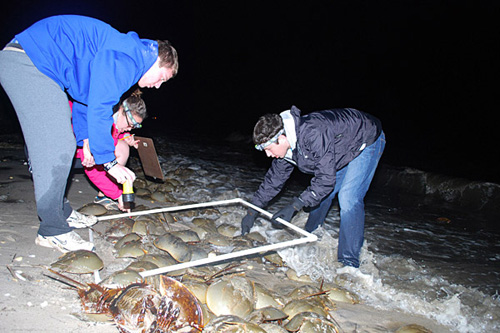Marine science majors conduct field research with horseshoe crab census
Wearing sneakers and rain boots, University of Delaware freshmen got their feet wet as marine biologists recently while counting horseshoe crabs along the Delaware Bay. The students participated in a monitoring effort to gain firsthand experience in field research with their fellow marine science majors.
“Where else can you go on a Saturday night to count horseshoe crabs?” freshman Will Goldman said.
After receiving training in April through the Delaware Bay Horseshoe Crab Spawning Survey, two dozen students gathered in the evening at the St. Jones Reserve in Dover and dispersed to nearby beaches with an experienced volunteer leading each group.
Thousands of horseshoe crabs lined the shores at high tide, congregating into clumps and slowly creeping along the sand in search of mates. The females lay small, round green eggs in the sand as males attach themselves to their backs for fertilization.
The students took a one-meter square made of PVC pipe and laid it on the sand at the “crab line” where the animals gathered, counting how many horseshoe crabs of each gender were within the quadrat. They repeated the process every 20 meters until they covered 1,000 meters of shoreline.
UD marine science majors gained field experience with horseshoe crab research. Video by Teresa Messmore
The data collected will be combined with counts from other locations taken in May and June at night during new and full moons, when horseshoe crabs swim onto beaches to breed. The first census in Delaware Bay was organized by Delaware Sea Grant in 1990 and now includes multiple organizations. The populations are studied in connection with fishing, pharmaceutical applications and shorebirds that rely on horseshoe crabs eggs for food during migration.
By volunteering with the project, students gain valuable field experience. At this early stage of their college careers, many students are enthusiastic about studying the ocean and sea life, but are not sure specifically how they will use their degrees.
Joanna York, undergraduate program coordinator with the School of Marine Science and Policy, said there are many options. Students go on to work at consulting firms and government agencies, attend graduate school, teach secondary education or even enroll in medical school.
“Our goal is to have the degree very well supported by the basic sciences because marine science – including marine biology and oceanography – is very interdisciplinary and it’s really hard to do marine science if you haven’t had a broad science background,” York said.

Marine science majors (from left) Eadoh Reshef, Megan Nogan and Jonathan Dinman volunteered with a horseshoe crab survey while gaining experience in field research. Photo by Tammy Beeson
The marine science major was formally approved in February 2011, making this year’s freshmen the inaugural group to start in their first years. York teaches several colloquia classes on marine science to complement students’ studies in biology, chemistry, math and other requirements.
“My goal is to immediately get students involved in doing things not just in the classroom, not just reading books and sitting in classes, but immediately doing and seeing and experiencing it because that’s what marine science is,” York said. “That’s why most of these students want to be in this major is because they’re excited about those kinds of opportunities.”
For many of the students walking Delaware’s shores for the survey, counting the spawning horseshoe crab population was a first exposure to data collection in the field.
“I’ve never done anything like this before,” student Kayla Krenitsky said. “It’s pretty cool.”
To learn more about undergraduate offerings in the College of Earth, Ocean, and Environment, visit this website.
– Article Teresa Messmore
*Source: University of Delaware
